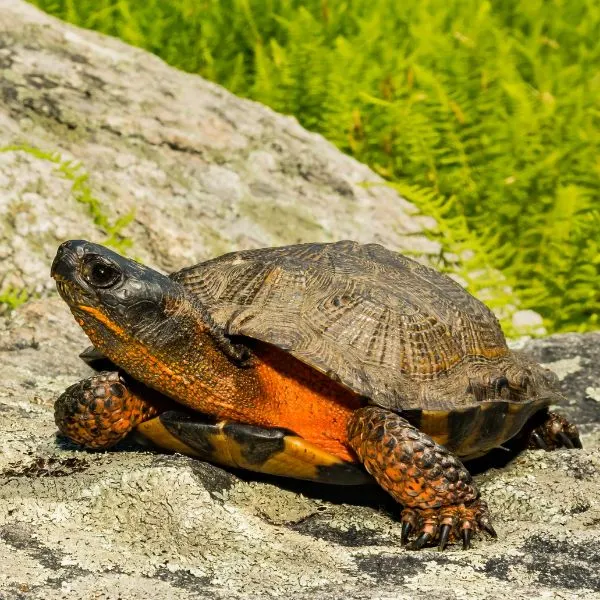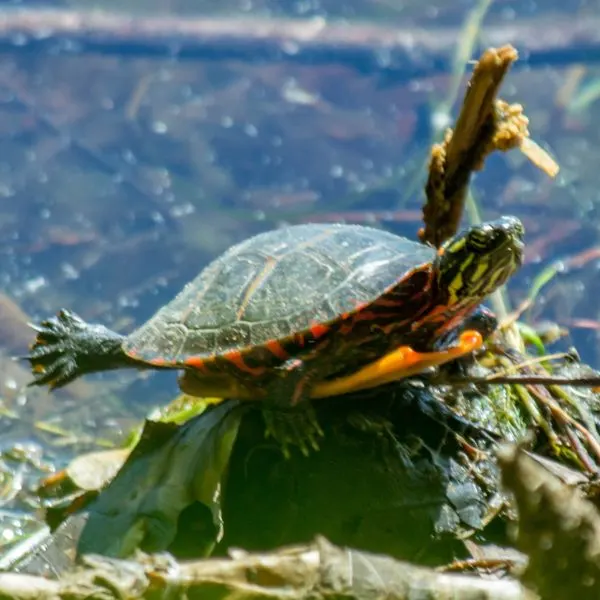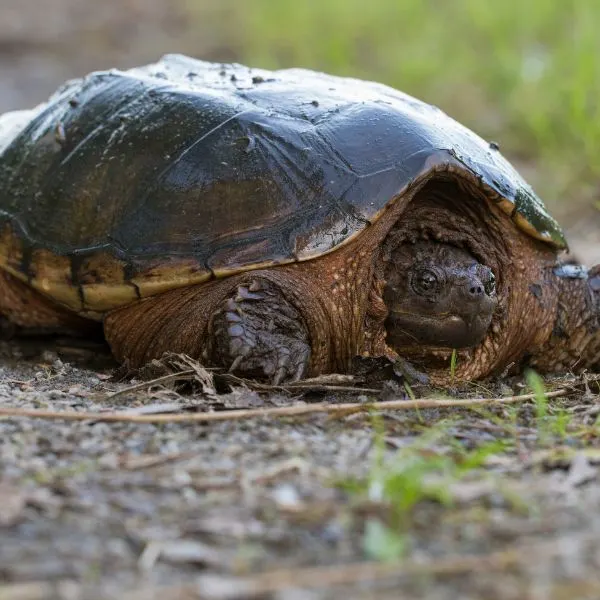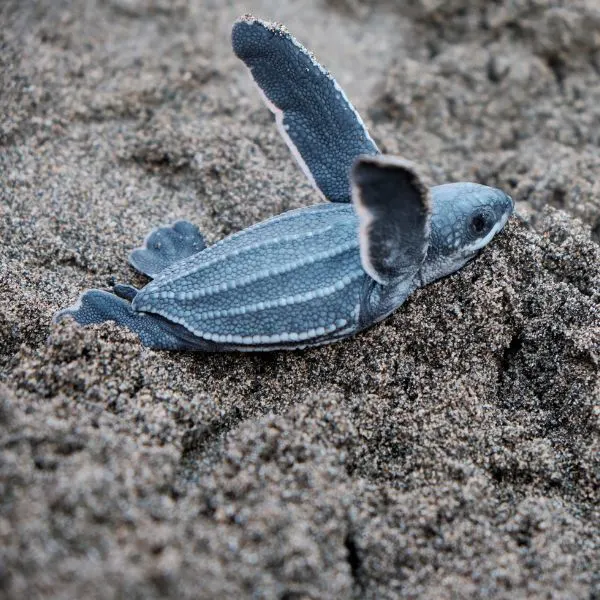There are 13 species of turtles living in and around Connecticut. Seven of these are freshwater turtles, while one prefers brackish waters, the Northern Diamondback terrapin. There are also 5 species of Sea turtles that might be spotted off the coast of the Constitution State if you’re lucky enough to see them.
This list will explore each of these native species, covering many aspects of their lives. You’re welcome to use this list as a field herping guide when you’re out on the trail. This list can also be used as a research list if you’re looking for your next pet turtle, as long as you don’t take them from their natural habitat.
Keep in mind that it is illegal to own some of Connecticut’s native turtles such as the Bog turtle. Others may have possession limits in place. Though we’ll cover these regulations, later on, it’s always important to research possession laws yourself as they frequently change.
If at all possible, please try and adopt a turtle from an animal shelter. If this isn’t possible, then we always recommend purchasing captive-bred specimens from a registered breeder. This helps reduce the illegal capture and sale of wild turtles.
Turtles that exceed 4 inches may be sold in Connecticut. Taking turtles from the wild negatively impacts native populations (and is illegal) so avoid this at all costs, and don’t buy wild-caught specimens.
Now, let’s dive into the 13 native species of turtles in Connecticut.
Table of Contents
Types of Turtles in Connecticut
1. Bog Turtle

- Experience Level: *Expert
- Family: Emydidae
- Scientific Name: Glyptemys muhlenbergii
- Other Names: Muhlenberg’s turtle
- Adult Size: 3.5 to 5 inches (9 to 12.5 cm)
- Lifespan: Up to 40 years
- Average Price Range: Illegal to own in Connecticut
- Conservation Status: Endangered
Bog turtles are North America’s smallest turtle species. These Endangered turtles are Connecticut’s rarest species, usually only seen in the western counties of the state. It is illegal to sell or own a Bog turtle in Connecticut.
They inhabit wetland areas such as bogs or marshes with lots of grass cover. One of the many problems these tiny turtles are facing is the drainage of their favored wetland habitats. Because they are so small and cute, these turtles are a favorite for the illegal pet trade, which is still reducing their wild numbers.
The Bog turtle doesn’t make a great pet. Yes, they are incredibly adorable, but they are also incredibly shy. In enclosed habitats, they stay hidden away most of the time.
Also known as Muhlenberg’s turtle, Bog turtles have dark colored shells, but may have some reddish or orange patterns on their scutes. The shell coloration may range from black, dark brown, to olive and they have a central keel ridge.
Their skin is also very dark but the head has a distinctive yellow or orange patch that adds to their visual appeal.
Bog turtles are diurnal omnivores, eating a diet of insects, snails, worms, carrion, and other meat when they can find it. They also eat berries, seeds, and other pieces of vegetation. Though active during the day, they tend to hide in the heavy vegetation and mud during the warmest summer days, and cold mornings.
Bog turtles are a flagship species. That means they are an animal that inspires people to save their habitat as a result of wanting to save the turtle itself. Because of this need to save the turtles, the wetlands, bogs, and all the animals that rely on these habitats are being saved as well.
(* Bog turtles are a federally protected species. As such, it is illegal to take, buy, or sell these animals or their eggs. Though it still happens, it shouldn’t be done. Not only are they protected, but these turtles are inherently shy, often stay hidden, and are hard to keep.)
2. Eastern Box Turtle

- Experience Level: Beginner
- Family: Emydidae
- Scientific Name: Terrapene carolina carolina
- Other Names: Land Turtle
- Adult Size: 4 to 7 inches
- Lifespan: 50 to 100 years
- Average Price Range: $260 – $360
- Conservation Status: Special concern in Connecticut
Eastern Box turtles are a species of Special Concern in Connecticut and can be found in various parts of the state. These turtles are terrestrial, meaning they spend most of their time on land and inhabit grassland and woodland regions with access to ponds.
While box turtles can swim, they aren’t very good at it, and often only visit watery areas to cool off and to get a drink. Younger box turtles may spend more time in the water as they search for food, but as they get older, they spend more time on land.
Eastern Box turtles have dark brown shells with high domes and distinctive yellow and orange stripes and dots. Their plastrons (bottom of their shell) are also dark brown and are concave in males and flat in females. Their skin is brown with more distinct orange or yellow markings.
Males often have red eyes while females have brown or yellow eyes, though this isn’t a definitive trait.
Box turtles are able to fully pull themselves into their shells for protection. They have moveable hinges on their plastrons that most predators can’t pry open.
These terrestrial turtles are omnivores, consuming small frogs and toads, insects, fruits, snails and slugs, plants, and even carrion on occasion. They can roam up to 55 yards in a day while searching for food. Though they travel fairly far distances compared to their size, most Box turtles stay within 250 square yards of their original nests.
3. Northern Diamondback Terrapin

- Experience Level: Beginner to Intermediate
- Family: Emydidae
- Scientific Name: Malaclemys terrapin terrapin
- Other Names: Diamond-backed terrapin
- Adult Size: 4.5 to 9 inches (11.5 to 23 cm)
- Lifespan: 25 to 40 years
- Average Price Range: $250 to $600 (Illegal to own in CT)
- Conservation Status: Special concern in Connecticut
Northern Diamondback terrapins are the only aquatic turtles that exclusively inhabit brackish waters. In the Constitution State, they are mainly found in tidal estuaries and salt marshes west of the Connecticut River.
To deal with the salt they consume, Diamondback terrapins have glands in their eyes that release excess salt. This is the same mechanism that sea turtles use to rid their bodies of too much salt. It may look like they are crying, but they are just regulating salt in their bodies.
Northern Diamondback terrapins have light gray skin with plenty of black speckling. They have thick webbed feet on their hind legs and are great swimmers.
Their shells range from black, brown, or gray, and have black concentric rings or circles on their scutes. Diamondback terrapins have a wedge shaped carapace (upper shell) that’s wider at the back, and there is a raised ridge running along the top.
This little salty turtle was headed toward the brink of extinction because humans over harvested them. They were considered a delicacy in the 1900s, but as populations declined, so did the need for terrapin meat. Their numbers rebounded, but they are still threatened because of coastal development.
In 2015 the Diamondback terrapin was listed as a special concern species and is now protected. It is illegal to take the Diamondback terrapin from its habitat, to possess, or to own this turtle in Connecticut.
These mostly carnivorous turtles feed on crabs, snails, clams, fish, insects, and worms. Occasionally they will consume small amounts of vegetation but clearly prefer meat.
4. Eastern Musk Turtle

- Experience Level: Intermediate
- Family: Kinosternidae
- Scientific Name: Sternotherus odoratus
- Other Names: Common Musk turtle, Stinkpot
- Adult Size: 4 to 5 inches (10 to 12.5 cm)
- Lifespan: 30 to 50 years
- Average Price Range: $30 to $120
- Conservation Status: Least concern
Common Musk turtles are a small aquatic species that prefers boggy or marshy habitats with clear, slow-moving waters. These turtles are one of the very few animals that actually benefit from waterway damming. These structures provide the slow moving waters the Musk turtle prefers.
They are also known as “Stinkpots” thanks to the strong odor that they can release from their musk glands as a defense mechanism. In addition to slow moving, muddy bottomed waters, the stinkpot looks for areas with heavy vegetation.
Despite being mostly aquatic turtles that hardly leave the water, they are clumsy swimmers. They use the heavy vegetation to climb to the surface and move around in the waters. Not only can they climb watery vegetation, but they often climb trees when they leave the water!
Common Musk turtles have unmarked shells that can be black, tan, dark brown, or gray-green in color. The Musk turtle has a large, triangular shaped head in relation to other turtles found in Connecticut.
The head also has yellow lines running from the nostrils beyond the eyes and often down the neck. Under the stinkpot’s chin and farther down on the throat are pairs of fleshy barbels.
These small turtles are nocturnal omnivores that mainly eat small amphibians, crustaceans, and mollusks. They will climb aquatic vegetation in search of snails, tadpoles, and fish that use the plants as protection.
5. Eastern Painted Turtle

- Experience level: Beginner
- Family: Emydidae
- Scientific Name: Chrysemys picta
- Common Name: Painted Turtle
- Average Adult Size: 4 – 10 inches
- Life Span: 30 – 50 years
- Average Price Range: Between $30 to $150
- Conservation Status: Least Concern
Eastern Painted turtles are the most common species in Connecticut and the nation. They are the only turtle species found from coast to coast, and from Canada to the Gulf of Mexico.
Painted turtles prefer quiet, shallow waters like marshes and ponds, but they can be found in lakes, reservoirs, and rivers. They are often seen basking on floating logs or sandbars, though they will quickly slip into the water when they feel threatened.
These medium-sized aquatic turtles are a popular pet species because they are active, brightly colored, and take well to home enclosures and ponds.
Eastern Painted turtles have dark colored, slightly domed carapaces with reddish markings on the fringe. Their scutes occur in straight rows with pale front edges running parallel to each other. Eastern Painted turtles also have yellow, orange, or slightly white stripes running down their faces, necks, and limbs.
Painted turtles have webbed feet and are great swimmers. Males are slightly smaller than females and have longer front claws and longer tails.
All subspecies of Painted turtles are omnivorous. Depending on the environment, painted turtles will eat amphibians, fish, insects, mollusks, and vegetation. They may also feed on worms and carrion.
6. Common Snapping Turtle

- Experience level: Intermediate to Expert
- Family: Chelydrida
- Scientific Name: Chelydra Serpentina
- Common Name: Snapping Turtle, Snapper, Eastern Snapping Turtle
- Average Adult Size: 8 to 20 inches
- Life Span: 30 – 50 years
- Average Price Range: Approximately $40 to $120
- Conservation Status: Least concern
Common Snapping turtles are widespread across most of Connecticut. They usually prefer larger bodies of water such as lakes or reservoirs and are Connecticut’s biggest freshwater species. These turtles can also inhabit brackish water, but that can be pretty rare as they prefer freshwater.
Although they can be legally kept as pets, they are suitable only for intermediate or expert keepers. They need very large enclosures and can be somewhat aggressive when taken from the water.
Common Snappers are famous for their powerful, hooked beaks, strong claws, and long tails covered with saw-toothed spines. Their thick dark brown, black, or green shells have three prominent ridges in the center that become less noticeable as the turtle ages.
These aquatic turtles will eat whatever they can catch, with juveniles being more active hunters. Adult Snapping turtles prefer to hang about the bottom of muddy or sandy waters and wait for food to swim by. When something gets close, they strike out and “snap” down with their strong jaws.
Snapping turtles are omnivorous. They will consume amphibians, fish, smaller turtles, and even waterfowl if they can get close enough. About a third of their diet consists of aquatic vegetation.
7. Spotted Turtle

- Experience Level: Intermediate to Expert
- Family: Emydidae
- Scientific Name: Clemmys guttata
- Other Names: Polka-dot turtle, “Spotty”
- Adult Size: 4 to 5 inches
- Lifespan: Males up to 65 years; females up to 110 years
- Average Price Range: $200 to $300
- Conservation Status: Special concern
Spotted turtles are a species of Special Concern in Connecticut and are limited to just one specimen per owner. These semi-aquatic turtles are found in parts of Connecticut with low elevations, preferring boggy and marshy habitats with shallow waters.
They are especially sensitive to pollution and populations will decline in watery areas that get even very little pollution.
Spotted turtles have smooth black shells that are covered with few, or many yellow-orange spots. Their plastrons are also yellow and have large black patches of varying sizes on either side. Their tails are fairly long and they have yellow, orange, or red patches on their cheeks and chins.
Females will often travel long distances after breeding in search of proper nesting sites. During this time, the little turtles are especially vulnerable to predators such as raccoons, skunks, and snakes. Many also meet their doom on busy roadways.
Spotted turtles are omnivores that usually eat a diet of crustaceans, insects, spiders, tadpoles, mollusks, and aquatic vegetation. These turtles have to feed underwater.
8. Wood Turtle

- Experience Level: Intermediate
- Family: Emydidae
- Scientific Name: Glyptemys insculpta
- Other Names: N/A
- Adult Size: 5.5 to 9 inches
- Lifespan: 40 to 60 years
- Average Price Range: $250 to $500
- Conservation Status: Special concern in CT
Wood turtles are another of Connecticut’s prohibited species. These turtles are listed as a Special Concern and can be found in various woodland habitats across the state. They need access to shallow, slow-moving ponds and streams that have sandy bottoms.
The Wood turtle is both terrestrial and aquatic depending on the season. When the days start to become cooler, the Wood turtle will retreat to their watery domain and brumate through the winter. When warmer temperatures return this little turtle emerges from the water in search of food and mates.
Wood turtles are named for their sculpted-looking shells. These are usually dark brown and sports patterns that resemble growth rings and wood grain. Their scutes can sometimes take on a pyramidal shape, which adds to their sculpted look.
These special turtles need a specific habitat to thrive, but these areas of woodlands along waterways are getting swallowed up by developers. This is forcing Wood turtles to travel farther for food and mates.
When they are searching for food, Wood turtles will sometimes do a little dance called the “Turtle Stomp.” They stomp their feet on the ground to imitate the pitter-patter of raindrops or the sound of moles.
This tricks earthworms into surfacing, and then the Wood turtle eats them up. Along with earthworms, Wood turtles will eat berries, insects, spiders, moss, fungi, algae, grasses, vegetation, and carrion.
Sea Turtles in Connecticut
Occasionally you may be able to see a few of the 5 species of sea turtles that visit Connecticut’s coastal waters. Most times these sea turtles can be found along the Long Island Sound. All species of sea turtles are Endangered and may not be sold or owned under any circumstances.
Hunting, nest poaching, fishing nets, and boats all have contributed to sea turtles’ population declines. It is now illegal to hunt, harm, or touch any sea turtles or their nests in the United States. Fishing trawlers are supposed to install sea turtle detection devices on their nets as well to help reduce the number of turtles that get trapped in them.
9. Atlantic Green Sea Turtle

- Family: Cheloniidae
- Scientific Name: Chelonia mydas
- Other Names: Green Sea turtle
- Adult Size: 3 to 4 feet (90 to 120 cm)
- Weight: 300 to 400 lbs (135 to 180 kg)
- Lifespan: 50 to 70 years
- Conservation Status: Endangered
- Habitat: Bays and shores along coastlines and open ocean waters, seen during summer months
- Clutch Size: Around 110 to 115 eggs, with 2 to 5 clutches per breeding season
- Food: Mostly herbivores, eating algae, sea grasses, and seaweed
- Appearance: Smooth green to brown shells shaped like hearts, edged in yellow. Cream colored scaly skin with shades of green.
Green Sea turtles are not very green on the outside. They get their name from the green fat underneath their skin which comes from the algae they eat. These turtles were often hunted for their meat and eggs, but the practice is now illegal.
Young Green sea turtles eat mostly meat such as fish, mollusks, crustaceans, insects, and worms. As they get older they start eating more and more vegetation until seagrass and algae make up the majority of their diet.
10. Kemp’s Ridley Sea Turtle

- Family: Cheloniidae
- Scientific Name: Lepidochelys kempii
- Other Names: Atlantic Ridley Sea turtle
- Adult Size: 24 to 27 inches (63.5 cm)
- Weight: 75 to 100 lbs (34 to 45 kg)
- Lifespan: Estimated around 30 years
- Conservation Status: Critically Endangered
- Habitat: Sandy or muddy coastlines with shallow waters
- Clutch Size: Between 100 and 110 eggs, 2 to 3 clutches per breeding season
- Food: Crustaceans, shellfish
- Appearance: Slightly hooked beaks, triangle-shaped heads. Green to gray round shells. Muted cream or yellow plastrons and undersides.
The Kemp’s Ridley sea turtle is the smallest of all the sea turtles. Incidentally, it’s also the most endangered of them all.
Of all the sea turtles, this is the only species that comes ashore and lays its eggs during the daylight.
11. Leatherback Turtle

- Family: Dermochelyidea
- Scientific Name: Dermochelys coriacea
- Other Names: Leatherback, Atlantic Leatherback
- Adult Size: 4 to 8 feet (182 to 213 cm)
- Weight: 1000 to 1450 lbs (545 to 658 kg)
- Lifespan: 30 – 50 years
- Conservation Status: Endangered
- Habitat: Warm waters, mainly shallow, calm bays or lagoons. Nests on sandy beaches.
- Clutch Size: Between 100 and 110 eggs
- Food: Jellyfish is the staple of their diet, but they will also eat other sea creatures
- Appearance: Their large carapaces are soft, and unique among sea turtles, with prominent ridges all the way down. Colors vary between black and dark gray.
The Leatherback sea turtle is the largest of all turtles in the world, getting as big and as heavy as a small vehicle. They also don’t have a hard shells. Instead, they have small bony plates on their backs, covered in a thick, leathery skin.
These turtles mainly feed on large jellyfish and may have to consume nearly 600 per day to keep up caloric intake. They will also feed on sea squirts and sea cucumbers.
Leatherback sea turtles are the deep diving turtle champions as well. They can dive up to 4,000 feet deep, and hold their breath for over an hour.
12. Loggerhead Sea Turtle

- Family: Cheloniidae
- Scientific Name: Caretta caretta
- Other Names: Loggerhead
- Adult Size: 30 to 45 inches (76 to 114 cm)
- Weight: Approximately 155 pounds (70 kg)
- Lifespan: 70 to 80 years
- Conservation Status: Endangered
- Habitat: Coastal regions, mainly shallow bays. Prefer subtropical waters. Sandy ocean beaches for nesting
- Clutch Size: Between 100 and 125 eggs, 4 to 5 clutches per breeding season
- Food: Carnivorous, mainly eating shellfish, mollusks, and crustaceans
- Appearance: Largest hard-shelled turtles with a reddish-brown carapace and large heads. Undersides are cream to yellowish. Long powerful flippers
Loggerhead sea turtles have wide, broad heads. This is because they have huge jaw muscles. If you thought the Alligator snapping turtle had a tough bite, the Loggerhead sea turtle can crack through conch and whelk shells.
These are their favorite foods along with horseshoe crabs. They use those massive jaw muscles to get through tough shells to eat the soft meat inside. They also eat fish, jellyfish, barnacles, and vegetation.
The Loggerhead sea turtle is the largest hard-shelled turtle. They can sometimes reach nearly 7 feet long, but they rarely do now because they typically don’t live long enough to reach such large sizes.
13. Hawksbill Sea Turtle

- Family: Cheloniidae
- Scientific Name: Eretmochelys imbricata
- Other Names: Hawksbill
- Average Adult Size: 30 – 36 inches
- Weight: 100 – 150 pounds
- Lifespan: 50 – 60 years
- Conservation Status: Critically endangered
- Habitat: Mangrove waterways, coral reefs
- Clutch Size: May nest 4 times per season in 2-week intervals. Nests will contain between 140 to 200 eggs per clutch.
- Food: Feeds almost exclusively on sea sponges
- Appearance: Radiating marble patterns on upper shells, a hawk-like beak, brown to black scales outlined in white to cream colored skin.
Hawksbill sea turtles have stunningly beautiful shells, but these unfortunately attract poachers. Tortoiseshell items such as combs, glasses frames, and other frivolous items are made after these turtles are caught and “processed.”
These turtles are mostly found along subtropical waters and coral reefs as they feed mostly on sponges. Watch out Spongebob! They also eat jellyfish, shrimp, fish, squid (Not Squidward!), and some coastal vegetation.
Frequently Asked Questions about Connecticut’s Turtles
What kind of turtles live in Connecticut?
Connecticut is home to 8 species of turtle, and the coastal waters are frequented by 5 different species of sea turtles. These turtles include Eastern Box turtles, Northern Diamondback terrapin, Common Snapping turtles, Wood, and Spotted turtles, and Eastern Painted turtles.
Four species of endangered Sea turtles can also be seen in the waters off the coast of Connecticut, particularly in the Long Island Sound tidal estuary. These are the Atlantic Green Sea turtle, Atlantic Ridley turtle, Leatherback turtle, Hawksbill, and Loggerhead turtle.
Are turtles illegal in Connecticut?
Unlike in some states, it is legal to keep some of Connecticut’s native species as pets. However, three species; Bog turtles, Northern Diamondback terrapins, and Wood turtles, are completely prohibited and can not be sold or possessed.
For more on Connecticut’s turtle possession laws, visit CGA.CT.Gov
Most turtles can be bought or sold as long as they are over 4 inches in length and are captive bred. Be sure you’re ready for such a responsibility, as turtles can be a lifetime companion. Most live for 30 or more years.
Can I keep a turtle I found?
You shouldn’t keep turtles you find in the wild, nor should you ever release a captive-bred turtle into the wild. These turtles usually don’t do well when taken from the wild or being released into the wild after being someone’s pet.
When looking for a pet turtle, try to adopt from reptile adoption agencies or qualified, licensed breeders.
Wrapping up
There you have it, all the native turtles that can be found in Connecticut. We hope you learned something and have a newfound appreciation for these shelled reptiles. Remember, like all wild animals, it’s best to leave them alone and let turtles do what they are going to do.
You can help them across dangerous roads as long as you are safe and help them toward the direction they are pointed.
Whether you use this list as a field herping guide or a way of choosing your next pet turtle, we hope you enjoyed it. If you did, please leave a comment down below and discuss Connecticut’s native turtles with us!
Other nearby states
Interesting stuff
